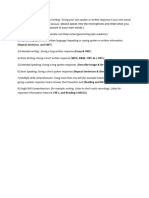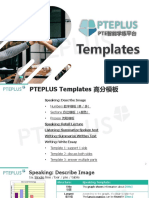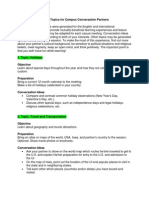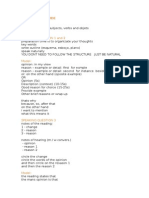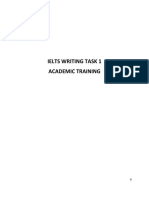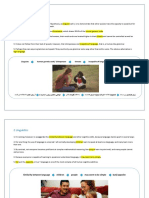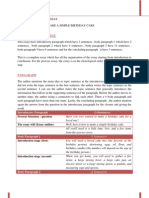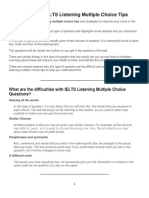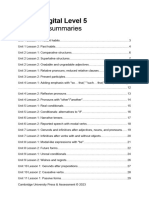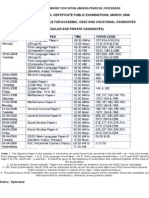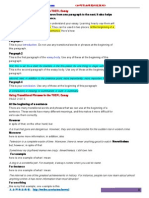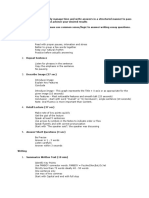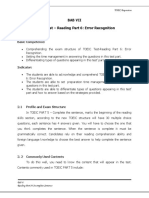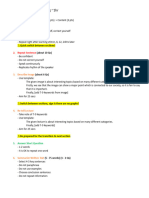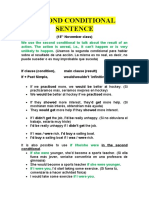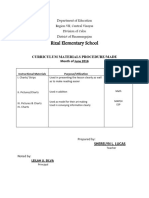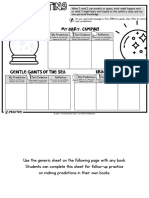Text Organization Structures
Text Organization Structures
Uploaded by
hannahdn77Copyright:
Available Formats
Text Organization Structures
Text Organization Structures
Uploaded by
hannahdn77Copyright
Available Formats
Share this document
Did you find this document useful?
Is this content inappropriate?
Copyright:
Available Formats
Text Organization Structures
Text Organization Structures
Uploaded by
hannahdn77Copyright:
Available Formats
Text Organization Structures – Introduction
Typically, information text is written to inform or persuade. Informational texts are textbook chapters,
newspaper and magazine articles, and reference materials. The ideas contained in informational text can be
organized in many different ways.
When readers are familiar with organizational pattern of texts, they are able to read the information with
specific questions in mind. Each organizational pattern suggests a number of questions that will be answered
within the texts. These questions help the reader understand the author’s message.
Authors incorporate signal words, or transitions that connect one idea to another. When students can point
out signal words and transitions as clues, they can recognize different text organizational patterns.
Students should be taught organizational patterns, one at a time, through a series of mini-lessons.
Suggested steps in this instructional strategy are:
1. Activate students’ prior knowledge of text structure and organization of information. This can be done
through brainstorming, or by posing a problem for students to solve, such as how they would order
their ideas if they wanted to explain to a child how to dribble a basketball, or convince their parents to
give them a raise in their allowance, etc. Discuss why they chose to organize their ideas in that
order.
2. Introduce an organizational pattern. Explain what the pattern is, its characteristics, when/why writers
use it, signal words of note, and what questions this pattern typically answers.
3. Provide an example of this pattern in a textbook or in a trade book. Informational trade books offer
information on a variety of content area topics, and organize information logically and coherently.
Model for students how to tell if the example fits into this category of organizational patterns.
4. Provide students with a graphic organizer that they can use to map out the information contained in
the sample. Demonstrate how to fill in the organizer. Explain that having visual representation of how
a text is organized will aid comprehension and retention.
5. Ask students to locate another example of this pattern in their textbooks, newspapers, magazines or
trade books. Students can then use a graphic organizer to diagram the information in the example
they select.
6. Have students write paragraphs using the pattern. This last step reinforces understanding and
enhances learning: Research indicates that readers who are taught to write and edit different types
of information text improve their reading comprehension of content textbooks. (Raphael, Kirschner,
and Englert, 1988). Students select a topic, gather any information they need, and map that
information onto a graphic organizer. Using this as a visual map, they write a rough draft and add
signal words where appropriate. Students can edit one another’s paragraphs. With this input,
students revise their rough draft, edit it, and write a final copy.
The desired outcome for students’ reading is the construction of meaning. The text structures, organizational
patterns, and strategies introduced serve as a resource for readers needing a framework to organize text;
however, an awareness of organizational patterns is meant to be a tool to support comprehension, not an
end in itself.
Mariely Sanchez © www.sanchezclass.com
Text Organization – FCAT Questions
1. At the end of the story, why does the author repeat her
description of the house?
2. What method of organization does the author use to
present the events of the poem?
3. If this article were published in a newspaper, which
would be the most informative headline?
4. Why does the author begin the article with a quotation
from ______?
5. Which sentence from the article offers the best
evidence that ______ was a success?
6. The author organizes the article by:
A. Comparing the struggles…
B. Listing the reasons…
C.Starting with flashbacks to…
D.Describing the personal qualities of…
7. What is the tone of the third paragraph of the passage
when ______ awakens to see the _______?
8. What is the purpose of the large illustration on page
_______?
9. How does the author introduce the characteristics of
_______?
Mariely Sanchez © www.sanchezclass.com
TEXT STRUCTURE
TRANSITION WORDS AND
PATTERN
PHRASES
First, second, always, then, next, later,
soon, before, finally, earlier, afterwards,
meanwhile, eventually, next week,
Time Sequence tomorrow, after, during, immediately,
preceding, third, initially, not long after,
now, today, as soon as, before, until,
following, on(date), then, when
Similarly, likewise, in addition, like, than,
Comparison as, neither…nor, either, or, by comparison,
as well as, both, in common, similar to
However, by contrast, yet, but, unlike,
instead, nevertheless, as opposed to, on
the other hand, although, but, as opposed
Contrast to, compared with, different from,
either…or, even though, instead of, still,
yet, on the other hand, otherwise
Since, because, thus, therefore, so due to,
as a consequence, accordingly, for this
reason, if…then, as a result, in order to,
Cause and Effect next, effects of, how to, is caused by, so
that, when…then, finally, how, leads/led to,
steps involved, begins with, first
The effect, one idea, the result, another, is
Problem/Solution resolved, question
In front, behind, next to, nearest, lowest,
above, below, outside, underneath, on the
left/right, in the middle, above, as in,
Descriptive between, looks like, outside, across,
behind, down, over, along, in back of, in
front of, on top of, onto, such as, appears
to be, beside.
Mariely Sanchez © www.sanchezclass.com
You might also like
- Speaking MaterialDocument12 pagesSpeaking MaterialoazakaaaNo ratings yet
- PTE Score Guide - Skill ProfileDocument1 pagePTE Score Guide - Skill ProfileKings learning Academy100% (1)
- PTEPLUS ModelDocument14 pagesPTEPLUS ModelangieNo ratings yet
- Conversation TopicsDocument6 pagesConversation TopicsSuzanne CyderNo ratings yet
- Question One: Independent SpeakingDocument4 pagesQuestion One: Independent SpeakingHân LêNo ratings yet
- Be and Have DescriptionDocument39 pagesBe and Have DescriptionJohnny Joe AguilarNo ratings yet
- Pte TipsDocument10 pagesPte TipsGayathri KodakandlaNo ratings yet
- Long Talk Listening in Paper Toefl Test: Nargis, M.HumDocument26 pagesLong Talk Listening in Paper Toefl Test: Nargis, M.HumNaufal Fadli AmzarNo ratings yet
- Tricks & Strategies in TOEFL Test-2Document14 pagesTricks & Strategies in TOEFL Test-2Muh. Saeful MHNo ratings yet
- TOEFL Little GuideDocument5 pagesTOEFL Little GuideLeonardoGontijo0% (1)
- SignpostingDocument4 pagesSignpostingukalNo ratings yet
- PTE READING FIB-WPS OfficeDocument3 pagesPTE READING FIB-WPS OfficeinstantechallanNo ratings yet
- Describing An ObjectDocument8 pagesDescribing An ObjectppdatascienceNo ratings yet
- Ielts Writing Task 1 Academic TrainingDocument77 pagesIelts Writing Task 1 Academic Trainingdream book100% (1)
- Skiming - EnglishDocument3 pagesSkiming - EnglishMohaiminur ArponNo ratings yet
- Sample Questions: Measuring SnowfallDocument1 pageSample Questions: Measuring SnowfallNguyễn Lâm100% (1)
- IELTS Speaking ExerciseDocument9 pagesIELTS Speaking ExerciseTanishsadan A100% (1)
- Your Interview: Coming To RavensbourneDocument12 pagesYour Interview: Coming To RavensbournelisaconnollyNo ratings yet
- Structure & Written Expression - Reading CompreDocument17 pagesStructure & Written Expression - Reading CompreMaryonoNo ratings yet
- Reorder ParagraphsDocument45 pagesReorder ParagraphsKhuram TabassomNo ratings yet
- Speaking TipsDocument11 pagesSpeaking TipsWarda DinNo ratings yet
- Ielts Writing Task 1 ProcessDocument10 pagesIelts Writing Task 1 ProcessJames DSNo ratings yet
- Tips and Tricks ToeflDocument6 pagesTips and Tricks ToeflSri Hartini FebriliaNo ratings yet
- Phrasal Verbs For TOEFLDocument4 pagesPhrasal Verbs For TOEFLAbi C. Ware0% (1)
- Problem and Solution EssayDocument13 pagesProblem and Solution EssaysachithraNo ratings yet
- Sample: Ielts Vocabulary - Writing Task 2Document2 pagesSample: Ielts Vocabulary - Writing Task 2Sara RamliNo ratings yet
- Process Essay ReviewDocument6 pagesProcess Essay Reviewmiss_amelliNo ratings yet
- Preposition and ConnectorDocument4 pagesPreposition and ConnectorGayan IndunilNo ratings yet
- IELTS Listening LessonsDocument46 pagesIELTS Listening LessonsHassan A. ShoukrNo ratings yet
- Agree - Disagree Essay : Structures For This Essay TypeDocument5 pagesAgree - Disagree Essay : Structures For This Essay TypeKhánh An VũNo ratings yet
- FCE ReviewDocument2 pagesFCE ReviewJo SeNo ratings yet
- To Be: Put The Correct Form of The Verb 'To Be' Into Each SpaceDocument2 pagesTo Be: Put The Correct Form of The Verb 'To Be' Into Each SpaceIza Costanda100% (1)
- 12 RulesDocument25 pages12 RulesSiddhrajsinh SolankiNo ratings yet
- 7 Handy Tips For Solving Parajumbles For Sbi Po PDFDocument9 pages7 Handy Tips For Solving Parajumbles For Sbi Po PDFKeshav Kumar SharmaNo ratings yet
- Linkers For Ielts Task 2Document9 pagesLinkers For Ielts Task 2Preet Mana Deol100% (1)
- Super PTE - Reading AnswerDocument3 pagesSuper PTE - Reading AnswerPradeep PaudelNo ratings yet
- Gre ToeflDocument18 pagesGre ToeflDivya HegdeNo ratings yet
- Evolve Digital Level 5 Grammar SummariesDocument34 pagesEvolve Digital Level 5 Grammar SummariesKatheryn Avellaneda100% (1)
- 6 Easy Ways To Write Complex Sentences in IELTS Task 2Document8 pages6 Easy Ways To Write Complex Sentences in IELTS Task 2Raman KumarNo ratings yet
- A.P. SSC/OSSC 2008 TimeTableDocument1 pageA.P. SSC/OSSC 2008 TimeTableDinakar.Tiruveedhi100% (10)
- TỔNG HỢP CÁC ĐỀ THI THẬT PROCESS HAY RA LẠI BY NGOCBACH PDFDocument7 pagesTỔNG HỢP CÁC ĐỀ THI THẬT PROCESS HAY RA LẠI BY NGOCBACH PDFNgoc AnhNo ratings yet
- Transition Words Passive VoiceDocument6 pagesTransition Words Passive VoiceArely CárdenasNo ratings yet
- PTE Answer StructureDocument3 pagesPTE Answer StructureIndika AmarakoonNo ratings yet
- Useful Phrases PDFDocument1 pageUseful Phrases PDFLordashNo ratings yet
- Mock Test Gi NGDocument8 pagesMock Test Gi NGVũ Đức ĐăngNo ratings yet
- Exam Questions of AssessmentDocument3 pagesExam Questions of AssessmentAhmad MustaqimNo ratings yet
- Bab Vii TOEIC Test - Reading Part 6: Error Recognition: Basic CompetenceDocument5 pagesBab Vii TOEIC Test - Reading Part 6: Error Recognition: Basic CompetencePutri HuriatiNo ratings yet
- Advantages Outweigh DisadvantagesDocument5 pagesAdvantages Outweigh DisadvantagesManoj KumarNo ratings yet
- IELTS General Writing Task 1 Complaint Letter - IELTS LeaderDocument1 pageIELTS General Writing Task 1 Complaint Letter - IELTS LeaderЕлизавета КононоваNo ratings yet
- Describing An Object - PPTDocument17 pagesDescribing An Object - PPThanzqanif azqaNo ratings yet
- Repeat SentenceDocument4 pagesRepeat SentenceMutazALqawasmi100% (1)
- Estimating Your TOEFL Speaking PDFDocument2 pagesEstimating Your TOEFL Speaking PDFForuhar ShaheidiNo ratings yet
- IELTS Preparation and Practice: ListeningDocument14 pagesIELTS Preparation and Practice: ListeningBhinderSinghNo ratings yet
- Transcription TestDocument1 pageTranscription TestDamia RdNo ratings yet
- PTE Notes and TemplatesDocument3 pagesPTE Notes and Templatespsnowfox1996No ratings yet
- Structure and Written Expression 1st MeetingDocument16 pagesStructure and Written Expression 1st MeetingSiska Lidya ReviantiNo ratings yet
- Soal To Be & Have HasDocument4 pagesSoal To Be & Have HasAndi Maryam100% (1)
- Sentence Transformation & Sentence CombinationDocument16 pagesSentence Transformation & Sentence CombinationMinh Thư Huỳnh100% (1)
- Discussion EssayDocument27 pagesDiscussion Essayglobalstudylinkers100% (1)
- Lesson 4 Patterns of DevelopmentDocument13 pagesLesson 4 Patterns of DevelopmentDennis EmNo ratings yet
- Introduction To CMIS 565 - Module 0: Course ObjectivesDocument4 pagesIntroduction To CMIS 565 - Module 0: Course ObjectivesStephen EfangeNo ratings yet
- (English (Auto-Generated) ) DWIN DGUS Software V7.64 - SE Tutorial - T5L Touch Screen (DownSub - Com)Document4 pages(English (Auto-Generated) ) DWIN DGUS Software V7.64 - SE Tutorial - T5L Touch Screen (DownSub - Com)mouhNo ratings yet
- Advanced JavaScript ConceptsDocument10 pagesAdvanced JavaScript ConceptsHusnain Ahmad MustafviNo ratings yet
- Curriculum VitaeDocument1 pageCurriculum VitaeYuri Luz da SilvaNo ratings yet
- Lesson Plan - Making RequestsDocument8 pagesLesson Plan - Making RequestsAizhamal BagytovaNo ratings yet
- E Stage 3 P840 02 AFPDocument12 pagesE Stage 3 P840 02 AFPnastase_maryana75% (4)
- WorkshopsDocument6 pagesWorkshopsKristina Brajkovic100% (1)
- Activity About Movie - Percy Jackson Aand Olympians The Lightning Thief. Advanced LevelDocument12 pagesActivity About Movie - Percy Jackson Aand Olympians The Lightning Thief. Advanced LevelLudy Copete Renteria100% (2)
- MakefileDocument114 pagesMakefileKhadim Ndiaye MbayeNo ratings yet
- SECOND CONDITIONAL SENTENCE (18th November Class)Document5 pagesSECOND CONDITIONAL SENTENCE (18th November Class)Nguyễn Thị Kim OanhNo ratings yet
- Visual Rhetoric Music Video Comparison Essay - Abby MckellopDocument5 pagesVisual Rhetoric Music Video Comparison Essay - Abby Mckellopapi-597591424No ratings yet
- NM - Vectors and Scalars - Lesson ADocument34 pagesNM - Vectors and Scalars - Lesson Ajohn jkillerzsNo ratings yet
- RfB2First - Speaking Part 1 - WSDocument1 pageRfB2First - Speaking Part 1 - WSCarina SivoNo ratings yet
- Department of Computer Science CSC 121 Test 3 Total Marks: 50 Duration: 2 HoursDocument4 pagesDepartment of Computer Science CSC 121 Test 3 Total Marks: 50 Duration: 2 HoursSiwe MavundlaNo ratings yet
- Curriculum MaterialsDocument4 pagesCurriculum MaterialsSherelyn Labrado LucasNo ratings yet
- 28 Travis Week11 Tutorial Q2Document3 pages28 Travis Week11 Tutorial Q2Travis TeohNo ratings yet
- Jayatirtha's "Padyamaala"Document4 pagesJayatirtha's "Padyamaala"NiranjanacharKalaleNo ratings yet
- Predicting Student Recording SheetDocument3 pagesPredicting Student Recording SheetTr. HelenNo ratings yet
- Managing Modeling and Visualizing High-DDocument19 pagesManaging Modeling and Visualizing High-DBobo bibiNo ratings yet
- What Is Package in JavaDocument6 pagesWhat Is Package in JavaVarmaNo ratings yet
- Social ProblemsDocument23 pagesSocial Problemsclaudine cordova100% (1)
- Special Products and Factorization: ModuleDocument39 pagesSpecial Products and Factorization: Modulekuku reenaNo ratings yet
- Challenges 4, Module 6 Lesson 2Document2 pagesChallenges 4, Module 6 Lesson 2Dijana MiNo ratings yet
- Roseberry, William - Balinese Cockfights and The Seduction of AnthropologyDocument13 pagesRoseberry, William - Balinese Cockfights and The Seduction of Anthropologylost.bifurcation4327No ratings yet
- Islamic WorldviewDocument26 pagesIslamic WorldviewNoor Aisyah Binti SajuniNo ratings yet
- Resume - Jahaysah Minsarah M. SaripDocument1 pageResume - Jahaysah Minsarah M. SaripJahaysah MinsarahNo ratings yet
- Jesus Saves Integrated School Foundation, Inc. Mabuco, Hermosa, Bataan Math 9 1 QuarteerDocument3 pagesJesus Saves Integrated School Foundation, Inc. Mabuco, Hermosa, Bataan Math 9 1 QuarteerNick GuevarraNo ratings yet
- WINSEM2019-20 ECE5014 ELA VL2019205005841 Reference Material I 10-Dec-2019 Arbiter SpecificationDocument4 pagesWINSEM2019-20 ECE5014 ELA VL2019205005841 Reference Material I 10-Dec-2019 Arbiter SpecificationAnonymous ptSFzcfNo ratings yet
- Gramatika Engleski Jezik 1 20232024Document51 pagesGramatika Engleski Jezik 1 20232024xp80yz90No ratings yet
- 4541-1688750102621-Unit 18 - Discrete MathematicsDocument17 pages4541-1688750102621-Unit 18 - Discrete Mathematicspraveenjayawickrama.88No ratings yet

